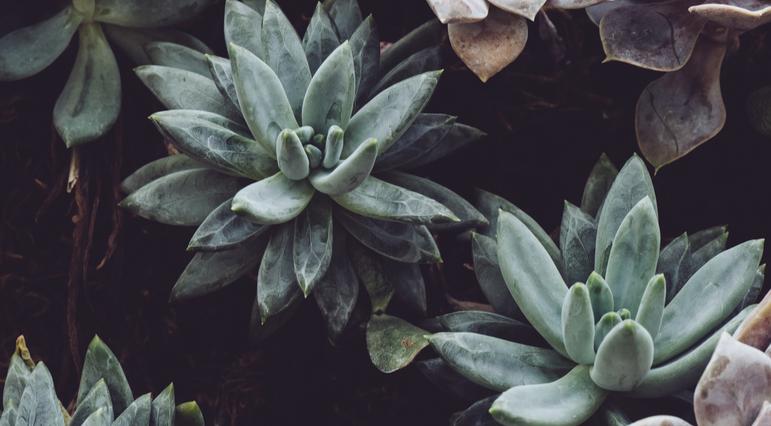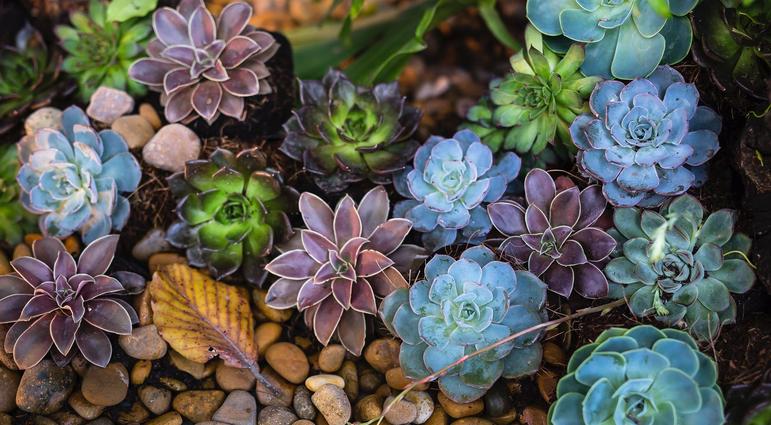Succulent Arrangements

Once you have a little knowledge, the world of container-growing succulents will open up to you. Succulents are so eye-catching because they come in such a variety of colors, shapes and textures from which you can make striking combinations. Most are drought-tolerant, which simplifies busy lives, and they are also easy to propagate to make more.
Because of their slow growth and ability to survive in less than optimal conditions, you can create many different types of arrangements in varied containers. Some of these unique creations will last only a short time if optimal plant conditions aren’t met, but then the plants can be reused for another project. You can grow succulents vertically in frames, in open terrariums, in moss balls, wreaths, unusual containers and even on jewelry. Succulent cuttings can be added to floral arrangements and later rooted to become a plant. Flowering stems of Kalanchoe will last well over a week without water. If you intend your creation to last a long time, you will need to follow the information:
Succulent Needs for Long Term Planting
Soil
The ideal soil retains some water but allows for great drainage, and some nutrients. A good soil mixture is 2 parts diatomaceous earth with one-part coconut coir. A prepared cactus or succulent soil can be used but make sure it has adequate mineral components for drainage, such as diatomaceous earth, gravel, or grit, which won’t compact. Don’t use too much sand as its particle size actually attracts water, so it’s moisture retention and wicking ability is greater than you would think.
Light
Bright, indirect light is needed for most succulents indoors. The more, the better, but not direct afternoon sun. Here are some tips if you only have lower intensity light:
Succulents that grow in part sun or shade in nature do better in the home environment. Examples are most Haworthia, Gasteria and Sanseveria species (there are short- growing forms of Sanseveria). The natural habitat for Rhipsalis and Schlumbergera species is shady and humid so these also do well in a home with lower light. Slower growing forms also require less light, which includes many cacti. Succulents that are naturally green do better in lower light than those with bright colors. Also, a trailing variety can look more natural stretching for light and adds variety to your design. Examples of branchy or trailing succulents are Crassula ovata and Senecio rowleyanus.
You can also use artificial light; no special fixture is required. Both fluorescent (tubes or compact bulbs) and LED bulbs emit light with little damaging heat. Look for full-spectrum fluorescent bulbs or Horticultural LED grow-lights since they produce only the wavelengths most utilized by plants and can be placed several inches from the plant for optimal exposure. Succulents need lights that emit at least 2,000 lumens per square foot with an optimal color temperature of at least 5,000 kelvins. Depending on the availability of any nearby natural light, artificial light should remain on for 12 to 18 hours per day.
Water
Proper watering is probably the most important aspect of growing healthy succulents. Provide well-draining soil in a pot that has a drainage hole. In the growing season (usually spring/summer but the time of year may differ among succulents so be observant), water approximately weekly or so after the soil has dried out for a couple of days from the previous watering. When plants are not growing actively, watering should decrease. But plants grown indoors may have their growth cycles disrupted by steady temperatures and less daylight change. Coupled with dryness from indoor heat, you may not need to lessen watering much in winter.
To water, soak thoroughly until water begins to flow from the drainage hole. Use a saucer or tray to protect your furniture but it is better to water at the sink, allowing the pot to drain before returning it to the saucer. There should be no standing water in the saucer. Avoid getting water on the leaves or rosettes. Use a watering can with a narrow spout to direct water between tight plants. Also, a watering stone positioned in the arrangement can provide a surface for the water to run across and enter the soil. Misting may help for some short-term projects, but for good root growth, it is not recommended for long-term arrangements.
Containers
Since soil moisture is also managed by the plant, container size is important. If the container is too large, or plants aren’t grouped tightly enough, there will be too much soil moisture for the plant to be able to expel through transpiration. It is better to re-pot periodically to provide for growth rather than put a small plant in a large pot expecting it to eventually fill the container. Unless the plant has heavy, thick roots, shallow pots are generally better than deep pots.
Containers can be made of many materials. As air and moisture transfer best through terra cotta, it provides excellent soil conditions. Glazed ceramics, although not as porous as terra cotta, are also excellent. Glass, plastic, concrete and hypertufa are also used. Metal can be used but the eventual rusting is not beneficial for plants and if located in sun, may become too hot for roots or leaves touching it.
Planting
Try to group plants by their needs for water and sun, and by how aggressively they grow. You can arrange your plants using many design schemes, including by color (complementary, monochromatic, analogous), height (thriller, filler, spiller designs or as all one height), and by using a container that complements the pot in color, texture or shape. Intersperse a mosaic of different plants or make groupings of the same plants.
Once you’ve decided on your plants and container, start by placing enough soil in the bottom of the container to position the succulents so they can be watered without overflowing the pot. That said, arrangements are sometimes more appealing if they mound in the center slightly higher than the rim. Begin with the largest plant in the center or rear and fill in with smaller plants. Place each successive plant next to the one just planted so you can fill them in tightly. A spoon is helpful to direct potting soil and a small painter’s brush can be used to wipe soil from plants. A top-dressing of stones, gravel, moss or shells can make your plantings stand out, prevents soil from washing on the plants when watered and keeps excess moisture away from the base of the plants. Choose the right type and color to go with the theme of your arrangement.
A great addition to your 'Living' space
If you use this information as a starting point for succulent care, you’ll be creating awesome succulent arrangements that can be designed for any part of your living space.

-
128 Raleigh St, NC 27540